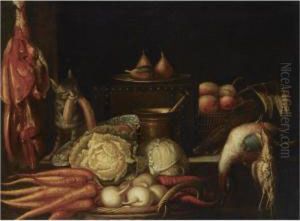Abraham Van Blyenberch Paintings
Abraham van Blyenberch was a Flemish portrait painter, hailing from Antwerp and active in the early 17th century. The exact dates of his birth and death are not well documented, but he is believed to have been born around 1575. Van Blyenberch's life and work are somewhat obscure, and much of what is known about him comes from the study of the portraits attributed to his hand.
Van Blyenberch was a contemporary of Peter Paul Rubens, and although he did not achieve the same level of fame, he was a respected artist in his own right. His style was distinctive for its detailed characterizations and the use of lighting to enhance the psychological depth of his subjects. He is known to have been active as a painter from around 1597 to at least 1624, based on dated works.
Not much is recorded about Van Blyenberch's early life or training. It is likely that he received his artistic education in the thriving cultural environment of Antwerp, which was a center for the arts in the southern Netherlands during that time. His clientele included nobility and the wealthy bourgeoisie, which was typical for portrait painters of his era.
One of Van Blyenberch’s most famous works is the portrait of the English philosopher and statesman Sir Francis Bacon. This painting, dated to 1617, is significant for its detailed representation and is one of the few authenticated likenesses of Bacon. Van Blyenberch's portraits are characterized by a certain stiffness and formality, reflecting the conventions of the time.
The details of Van Blyenberch's later life and death are not well-documented, and his body of work is relatively small, with only a handful of paintings confidently attributed to him. Nonetheless, those that survive contribute to our understanding of portrait art in the Low Countries during the transition from the late Mannerist to the early Baroque period. His works are held in various collections and continue to be studied by art historians interested in the period.

